Revista Electrónica de Investigación Educativa
Vol. 10, Num. 2, 2008
Assessment of Cognitive Changes in Ecological Concepts,
in Mexican Junior High School Students
Sergio Rodolfo Torres Ochoa
storres@zeus.umich.mx
Centro de Didáctica y Comunicación Educativa
Universidad Michoacana de San Nicolás de Hidalgo
Edificio M, PA, Ciudad Universitaria s/n
58040
Morelia, Michoacán, México
(Received: March 14, 2007;
accepted for publishing: July 15, 2008)
Abstract
This study was made from a random sample of students of secondary school (basic education), in urban an rural schools of the public sector of the state of Michoacán, Mexico. Significant cognitive changes of basic concepts of Ecology, during the whole academic year were assessed in each one of the three grades which conform this level of education. For such purpose, a group of six fundamental and four complementary concepts was used with which a core concept diagram was elaborated. From this diagram, a 23 task questionnaire was designed and applied as conceptual assessment instrument. The general results show that there are no significant differences, statistically speaking, between the beginning and the end of the academic year, regarding the principal Ecology concepts and other related concepts that were assessed as well. This study included an interpretative phase based in conceptual maps, which results are not included in this article.
Key words: Concept formation, ecology, cognitive processes, science education, scientific concepts.
Introduction
The results presented here are part of a study financed by the Secretariat of Public Education (SEP), the National Council of Science and Technology (CONACYT), and the Michoacan University of San Nicolas of Hidalgo (UNSNH), Mexico: SEPSEBYN-CONACYT-2003-C01-2.
Today, a well-educated society is the society with a basic conceptual management of Ecology. Ecological literacy is now a task recognized by every social sector, and is accepted as an intellectual critical mass that permits an awareness of environmental degradation under features of human activity publicly acknowledged as environmental contamination.
In this sense, the school, from the perspective of basic ecological education, plays a leading role, and the assimilation of the basic concepts of ecology within the scope of formal school education is a priority function. It acquires special relevance with regard to basic levels of education. From the cognitive point of view, adolescence is a time of intellectual growth when the school or any other educational mechanism has considerable influence on other educational levels.
Junior high school education in Mexico is focused on children between 12 and 15 years of age, in that period of human development identified as adolescence. This is the age when the neuronal processes are in the course of physiological fixation, which provides ample opportunities for the reformulation of learning. It is at this time that the mechanisms of educational involvement are crucial for the future of these adolescents. The use of this biosocial circumstance to achieve the learning of science is a challenge that can not be pedagogically underestimated, particularly in the case of ecological literacy, whose basic cognitive function is of strategic importance for all of society, and presents favorable conditions for intervention by teachers.
Conceptual organization for the learning of formal knowledge (Campos and Gaspar, 1996a, 1996b), was analyzed in comparative studies done with students of various class levels (Alucema, 1996; Campos, Sanchez and Gaspar and Paz, 1999; Cortes, 2000). These studies showed the difficulties of conceptual assimilation regarding depth and integration. Using sociocultural theory as a basis, there were explored such curricular aspects as the relationship between research and teaching, and the unification of discipline and profession (Campos, Gaspar and Alucema, 2000). On the other hand, researchers recently studying the teaching and learning of biology, revealed students’ persistent difficulties in understanding the basic micro and macrocontextual concepts related with biological evolution (Alucema, 2001), particularly the categories of conceptual organization of knowledge (Ausubel, 1973) and of category construction (Neisser, 1989).
I. Theoretical framework
1.1 Cognition
Cognitive evaluation is a complex process, even from an epistemological point of view, because the innumerable categories involved in it have not yet been resolved. It is a matter in which psychology, the neurosciences and sociocultural references acquire special importance, and in which linguistics and semiotics are relevant.
Those of recent cognitivist postures, conscious of their theoretical and practical limitations, turn to epistemic reconciliations where the contributions of sociobiology, the retrieval of Piagetian approaches to the biology of development and the trends of connectionism are considered. The latter refer to the relationship of the architecture of cognition to multiple, interconnected, neural networks, which modulate both the thinking and the memory (Best, 2002). If a concept is, by definition, an abstraction, then the more abstract it is, the fewer sensorial components it has, and the more verbal elements. This is because concepts are constructed by society using, above all, verbal definitions (Alcaraz, 2001).
1.2 The junior high school in Mexico
Since the modification of Article 3 of the Political Constitution of the United States of Mexico in 1993, the Program of Educational Modernization has considered the elementary and junior high school as combined into just one stage of basic, obligatory education, composed of nine grade levels (six for the elementary level, and three for the junior high) (Sandoval, 2001).
In Mexico, the junior high school is part of a basic, obligatory, three-year school cycle distributed over one-year levels; these occupy one shift only: morning or evening. The students, adolescents between the ages of 12 and 15, attend school during six and a half hours a day, five days a week. On an average, the students attend school about 220 days a year. In this way each school complies with the official curriculum.
School differ in their ability to compensate for the effect of the student’s social origin, gender, or academic history (Cervini, 2005), a scholastic circumstance which is here analyzed in connection with the students. An interesting finding obtained in a study done in a Mexican junior high school, is that the courses those junior high school students prefer are the ones which especially imply intellectual challenges: Mathematics, Physics, Chemistry and Biology (Lozano, 2005).
1.3 Science and education
Today, nobody questions the fact that all formal education, in one way or another, is identified with science, or with scientific and technological work. Since this is accepted throughout all scolastic levels, there is a need for basic scientific literacy with various levels of origin, relating to the corresponding theoretical-pedagogical trend. Aside from this, it is appropriate to point out that, in cognitive terms, an integrated and significant literacy finds practical sustenance in moments of learning growth, i.e. when the subject is increasingly involved in the development of cognitive abilities —intellectual— with an ascending level of abstraction. Adolescence is a culminating moment of cognitive growth, and for this reason it is appropriate to believe that the consolidation of scientific thought, whose formal bases are of a conceptual order, could reside in this period.
However, it is not enough to take science to the school; the automatic transport of scientific knowledge to the school population is not necessarily a factor lending support to the scientific culture. On the other hand, in the school there is a tendency to magnify what science offers, for example, the implicit promise that after a relatively long training process, one will have achieved the ability to act and think like a scientist. It frequently happens that this promise for the future is left unfulfilled, even for university graduates. There is no guaranteed way to approach science and understand it, and school science classes of this type end up, paradoxically, by becoming enemies of science itself (Vazquez, Acevedo and Manassero, 2004).
1.4 Ecology and education
The basis of the conceptual approach to the problem of ecology is that “a conceptual system, either tacit or formal (scientific), is a thematic pattern of semantic relations that contains a variety of structural units, including the concepts and logical relationships that connect them” (Campos and Gaspar, 1996b: 56-57).
The term “ecology” is commonly used to refer to the environment, sustainable development, ecodevelopment, and associated subcategories such as pollution, environmental degradation, environmental deterioration, climate change and a long etcetera. It is not easy, even for science itself, to make an epistemological distinction between what is science and what is society (Nebel and Wright, 1999; Leff, 2000; Carabias and Provencio, 2001; Delgado, 2004).
Ecology, specifically, is that science which deals with the study of ecosystems (no organism can survive outside of its environment, or without relation to other species) (Nebel and Wright, 1999 Arana, 2004; Turk, Turk and Witte, 2004; Vazquez , 2004). Regarding the majority of environmental problems, these “...are characterized by a fluid and incomplete state of scientific knowledge, accompanied by unpredictable issues inherent in complex systems” (Funtowicz and De Marchi, 2000, p. 69).
II. Methodology
The methodological process used in this study was based on the theoretical approaches of cognitivism. The delimitation of the problem considered the epistemological characteristics of ecological science itself, for which reason relevant literature was reviewed, so as to catalog, decipher and clarify those concepts considered to be fundamental. Renowned ecologists from all over world, when surveyed, reached the conclusion that there are six primary concepts of this science (Burns, 1992). These six concepts and the scientific principles that underlie them appear in the conceptual schematic of Figure 1, and in Table I. It was necessary to consider other concepts, which may also appear in the schematic.
To design and construct the instrument of cognitive evaluation, we proceeded to the basic conceptual delimitation of Ecology. After reviewing specialized literature, we found a set of concepts fundamental to the understanding of Ecology, based on a survey of the global scientific community dedicated to Ecology. Of this set of concepts, the six which recur most often are, in all likelihood, the most important (Burns, 1992). There is undoubtedly a debate over this delimitation (Scheiner, Hudson and Vandermeulen, 1993); however, as an epistemological resource for the definition of Ecology as a concept, it is highly significant in terms of education. The basic character of these six concepts is based on their relationship to scientific principles. In the cells of Table I appear the six principles, and their association with those six concepts consensually considered as crucial.
Table I. Ecosystem: a strong concept
and a paradigm for ecology
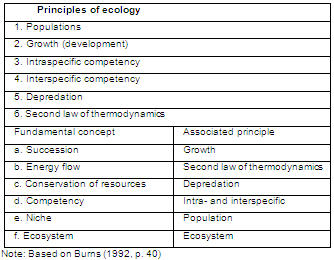
The base conceptual schematic was developed with the six key concepts. With the intention of giving interpretive congruence and comprehensive integrity to the figure, there were included three concepts categorized as complementary or additional; without these, from a pedagogical point of view, there would be extreme difficulty in the teacher’s ability to make a full clarification of the concept of ecology. The three concepts are organisms, distribution and habitat.
As a social concept, because of the political and ideological content it implies, there was included a concept inseparable from ecological discourse: environment, which has more links with the social than with the biological. Finally, there were included three questions (concepts) epistemologically related with the six fundamental concepts or the four complementary ones. The results are presented in Tables II, III, IV and V.
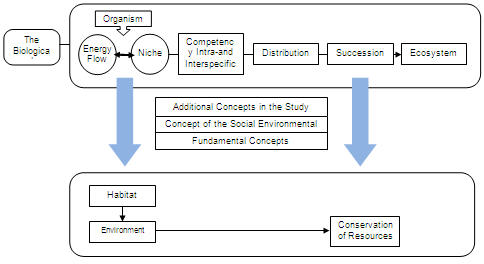
Figure 1. Basic conceptual schematic used for the study
Students from 21 schools, urban and rural, were surveyed. In each school, a group of five students were randomly selected from each level, making 15 per school. In this way, it was possible to obtain 315 instruments applied in the pre-test, and 315 in the post-test (630 tests in all). When processing the data it was necessary to eliminate several pre-test and post-test cases because they were not answered properly. The screening that led to an equal number of pre-tests and post-tests left the number of the sample at 312 for each (a total of 623 instruments evaluated).
The quantitative data from the set of instruments evaluated was entered on an Excel sheet, where incorrect answers were assigned a value of -0.5; correct ones a value of 1; and “I don’t remember”, a value of 0. Statistical analysis was carried out by using the student’s t-test for each answer (concept), and by considering the average of the responses of the 312 students of the final sample. I.e., 23 student t-tests were made for the total sample. Then the procedure was repeated, separating the sample into three subsamples for each level.
III. Discussion and conclusions
The interpretation and analysis of results, both quantitative and qualitative, permits an assessment, from the cognitive point of view, of an approximation of the conceptual assimilation of ecological science by the learners studied.
The set of 23 questions related to ecological concepts which this study included the instrument of cognitive evaluation, evidenced null cognitive assimilation during the three years of junior high school education.
When there was applied the analysis of quantitative differential evaluation, in which the sample is separated into subsamples of first, second and third years, the results were similar. The exception was found in the first year; for that year, in the three questions, there was found a significant statistical difference: producers and organisms. In these three cases, for the first year (random subsample of 106 students in pre-test, and 106 students in post-test; 212 students in total), the student T Proof significantly rejected the corresponding null hypothesis.
The question related to the concept biotic factors, was characterized in this study as illustrative of cognitive level. Epistemologically, this concept is catalogued as related with the fundamental concept Ecosystem.
The question producers was categorized also in the exemplificative cognitive level. Epistemologically, it is related with the complementary concept habitat.
Relating these three questions with the principles that theoretically sustain all ecological concepts, biotic factors are directly related with ecosystem, which contains its own principle, since it is a concept and an autonomous principle of ecology itself. From the epistemological point of view, biotic factors is an essential branch of any conceptual schematic prepared for cology. As to the cognitive level, its exemplificative character locates it as a subsidiary of any other that has explanatory character. That is, examples the management of conceptual examples implies obligatory relationships with one or more concepts of explanatory character.
Producers is a question directly related with the complementary concept habitat. This means that, in order to give it cognitive importance, it is necessary to relate habitat with at least two fundamental concepts: niche and ecosystem. The first of these is based on the principle population and the second, as noted above, is based on the same principle.
Organism, meanwhile, is a question categorized as explanatory, required for the full comprehension of succession, competency and energy flow. These three fundamental concepts, in turn, are directly associated with the principles growth, the intra- and interspecific, and the second law of thermodynamics (entropy). What is relevant to the concept organisms is that, besides its importance as an object of biological study, it has as subsidiaries the three fundamental concepts with which it is directly related. This has cognitive significance because it is necessary to have previous knowledge on the subject of organisms in order to introduce posterior and more specific knowledge about Ecology: succession, competency, and energy flow. Its category of explanatory concept also gives it pedagogical qualities for its curricular treatment as a fundamental antecedent for the full understanding of a critical theoretical body of ecological science.
Table II. Test for Student t-distribution, differential between pre-test
and post-test, in total sample of 312 junior high school students
in the state of Michoacan
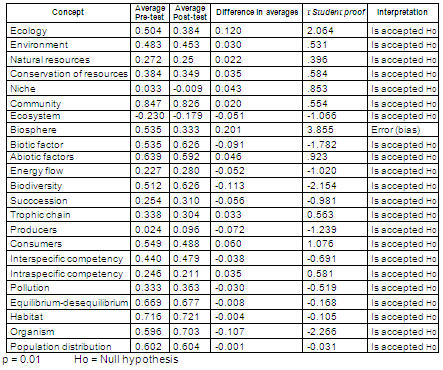
Table III. Test for Student t-distribution, differential between pre-test
and post-test, in total sample of 106 first-year junior high school students
in the state of Michoacan
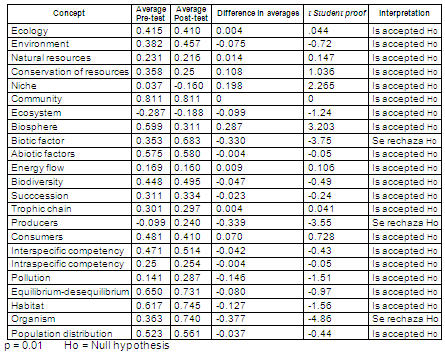
Table IV. Test for Student t-distribution, differential between pre-test
and post-test, in total sample of 100 second-year junior high school students
in the state of Michoacan
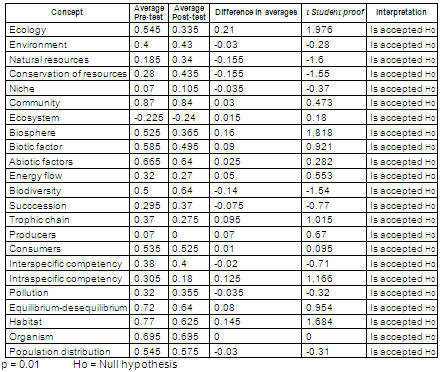
Table V. Test for Student t-distribution, differential between pre-test
and post-test, in total sample of 104 third-year junior high school students
in the state of Michoacan
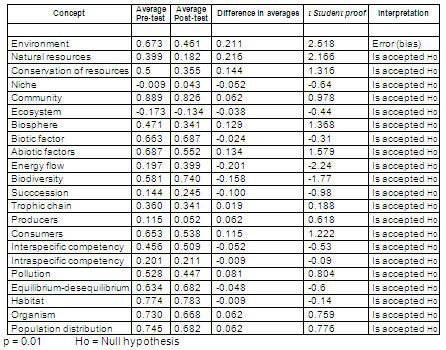
What has been pointed out up here, regarding the three concepts with significant statistical evidence for cognitive assimilation in the first year of junior high school, may provide an explanation for the curriculum and teacher involvement.
More contents with direct allusions to ecological concepts are observed in the official programs of Biology, Chemistry, Introduction to Physics, Geography, and History for the first level, than in the whole group of subjects for the other two levels combined: Biology, Chemistry, Physics, Geography and History.
In Michoacan, the contents of the most important textbooks we were able to locate, and which are used in the junior high schools, support this trend.
In terms of ecological concepts, what small amount of evidence there is for significant conceptual changes in Michoacan’s first-level junior high school students, has a curricular explanation shown by the appearance of these concepts In texts used for some courses, especially Biology, which has an entire section on Ecology. This is not true of levels two and three.
One conclusion regarding this, is that from the cognitive point of view, the assimilation of contents achieved in first level lingers in a diluted form during the second and third levels. This is demonstrated when the subsamples of 100 and 104 students of second and third level, respectively, showed no significant statistical difference between application of pre-test and post-test (beginning of the school year and end of the school year), in any of the 23 questions of the instrument, i.e. those addressing a minimum of the important ecological concepts which an educated citizen with a vision of ecology should have and use.
According to Burns (1992), when this training is based on scientific knowledge, it tends to consolidate knowledge of the subject, whose immediate references to the environment are encoded by what ecological science has to say. The conceptual basis of this critical training revolves, then, around of these key concepts:
1. Succession.
2. Energy flow.
3. Conservation of resources.
4. Intraspecific and interspecific competency.
5. Niche.
6. Ecosystem.
To evaluate the minimum knowledge conceptually supported by the foregoing, is to concede the scientific certainty of a formal management of this knowledge with respect to nature. Cognitive ability is also a certainty of involvement and transformation of the environment with reason-based responsibility for the exploitation of natural resources —renewable and non-renewable— which in general terms is known as sustainable development.
However, school training with a deficit of conceptual ecological information does not necessarily generate a panorama contrary to that mentioned in the preceding paragraph.
To inspect the complete cognitive evaluation instrument used in this study, and to obtain the set of results (Tables II-V), please access the following website: www.didactica.umich.mx
References
Alcaraz, V. M. (2001). Neurofisiología del lenguaje. In V. M., Alcaraz & E. Gumá (Comps.), Texto de neurociencias cognitivas (235-279). México: Manual Moderno-Universidad Autónoma de Guadalajara-Universidad Nacional Autónoma de México.
Alucema, M. A. (1996). Evaluación de las organizaciones conceptuales de estudiantes de biología referidas al concepto de evolución. In M. A. Campos & R. Ruiz (Eds.), Problemas de acceso al conocimiento y enseñanza de las ciencias (113-136). México: IIMAS-Universidad Nacional Autónoma de México.
Alucema, M. A. (2001). Procesos estratégicos en la construcción de contenido lógico-conceptual sobre la teoría evolutiva moderna en el nivel universitario. In M. A. Campos (Coord.), Construcción de conocimiento y educación virtual (1-34). México: Universidad Nacional Autónoma de México.
Arana, F. (2004). Ecología para principiantes. México: Trillas.
Ausubel, D. (1973). Algunos aspectos psicológicos de la estructura del conocimiento. In S. Elam (Comp.), Educación y estructura del conocimiento (211-237). Buenos Aires: Ateneo.
Best, J. B. (2002). Psicología cognoscitiva. México: Thomson.
Burns, T. P. (1992). Ecosystem: a powerful concept and paradigm for ecology. Bulletin of Ecological Society of America, 73 (1), 39-43.
Campos, M. A. & Gaspar, S. (1996a). Las condiciones inmediatas de la construcción del conocimiento: un esquema para el análisis de la interacción en el aula. In M. A. Campos y R. Ruiz (Eds.), Problemas de acceso al conocimiento y enseñanza de las ciencias (27-50). México: Universidad Nacional Autónoma de México.
Campos, M. A. & Gaspar S. (1996b). El modelo de análisis proposicional: un método para el estudio de la organización lógico-conceptual del conocimiento. In M. A. Campos & R. Ruiz (Eds.), Problemas de acceso al conocimiento y enseñanza de las ciencias (51-92). México: Universidad Nacional Autónoma de México.
Campos, M. A., Gaspar, S. & Alucema, A. (2000). Análisis de discurso de la conceptualización de estudiantes de biología de nivel universitario. Sociotam: Revista Interdisciplinaria de Ciencias Sociales y Humanidades, 10 (1), 31-71.
Campos, M. A., Sánchez, A., Gaspar, S., & Paz, V. (1999). La organización conceptual de alumnos de sexto grado de educación básica acerca del concepto de evolución. Revista Intercontinental de Psicología y Educación, 1 (1-2), 39-55.
Cervini, R. A. (2005). Variación de la equidad en resultados cognitivos y no cognitivos de la educación media en Argentina. Revista Electrónica de Investigación Educativa, 7 (1). Retrieved November 11, 2006, from:
http://redie.uabc.mx/vol7no1/contenido-cervini3.html
Cortés, L. (2000). Evaluación de la calidad conceptual de estudiantes de secundaria sobre el tema de célula. In M. A. Campos (Coord.), Construcción de conocimiento y educación virtual (35-73). México: Universidad Nacional Autónoma de México.
Delgado, G. C. (2004). Biodiversidad, desarrollo sustentable y militarización: Esquema de saqueo en Mesoamérica (60-61). México: Universidad Nacional Autónoma de México-Plaza y Valdés.
Funtowicz, S. & De Marchi, B. (2000). Ciencia posnormal, complejidad reflexiva y sustentabilidad. In E. Leff (Coord.), La complejidad ambiental (54-84). México: Siglo XXI-CIICH (UNAM)-PNUMA.
Leff, E. (2000). Pensar la complejidad ambiental. In E. Leff (Coord.), La complejidad ambiental (7-53). México: Siglo XXI.
Lozano, A., I. (2005). Los significados de los alumnos hacia la escuela secundaria en México. Revista Iberoamericana de Educación, 36 (9). Retrieved September 10, 2006, from: http://www.rieoei.org/deloslectores/1051Lozano.PDF
Nebel, B. J. & Wright, R. T. (1999). Ciencias ambientales: Ecología y desarrollo sostenible. México: Pearson-Prentice Hall.
Neisser, U. (1989). From direct perception to conceptual structure. In U. Neisser (Ed.), Concepts and conceptual development (11-23). Cambridge: Cambridge University Press.
Provencio, E. & Carabias, J. (2001). El enfoque del desarrollo sustentable. Una nota introductoria. In A. Azuela, J. Carabias, E. Provencio, & G. Quadri (Coord.) (2001). Desarrollo sustentable: Hacia una política ambiental (3-12). México: Universidad Nacional Autónoma de México.
Sandoval, F. (2001). Ser maestro de secundaria en México: condiciones de trabajo y reformas educativas. Revista Iberoamericana de Educación, 25. Retrieved June 5, 2006, from: http://www.rieoei.org/rie25a04.htm
Scheiner, A. M., Hudson, A. J. & VanderMeulen, M. A. (1993). An epistemology for ecology. Bulletin of the Ecological Society of America, 74 (1), (17-21).
Turk, A., Turk, J. & Wittes, J. T. (2004). Ecología-contaminación-medio ambiente. México: Mc Graw Hill.
Vázquez, A., Acevedo, J. A., & Manassero, M. A. (2004). Consensos sobre la naturaleza de la ciencia: evidencias e implicaciones para su enseñanza. Revista Iberoamericana de Educación (section De los lectores, electronic version). Retrieved June 10, 2006 from: http://www.rieoei.org/deloslectores/702Vazquez.PDF
Vázquez C. (2004). Ecología y medio ambiente para bachillerato general. México: Publicaciones Cultural.
Translator: Lessie Evona York-Weatherman
UABC Mexicali
Please cite the source as:
Torres, S. R. (2008). Assessment of cognitive Changes in Ecological concepts, in Mexican Junior High School Students. Revista Electrónica de Investigación Educativa, 10 (2). Retrieved month day, year, from: http://redie.uabc.mx/vol10no2/contents-torresochoa.html





